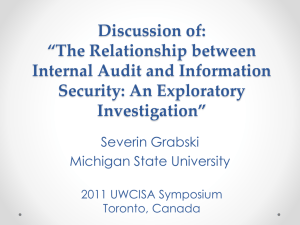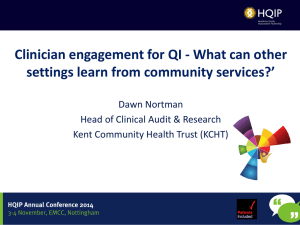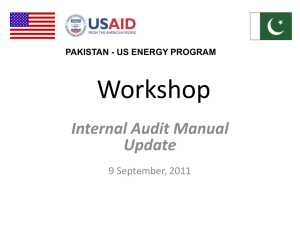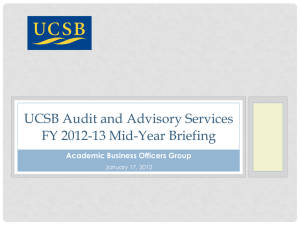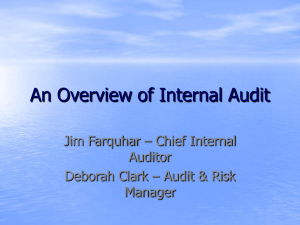Revisiting 9101-2009
advertisement
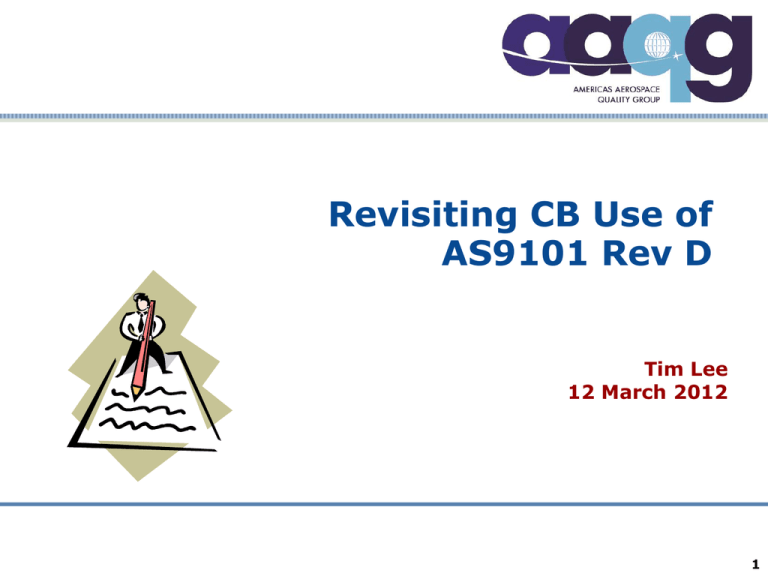
Revisiting CB Use of AS9101 Rev D Tim Lee 12 March 2012 Company Confidential 1 Reminder AS9101 Rev D Fundamentals • 9101 defines requirements for the preparation and execution of the audit process • It defines the content and composition for the audit reporting of conformity and process effectiveness, based on – 9100-series standards requirements – the organization’s quality management system documentation, and – customer/regulatory requirements • It builds on and mandates requirements and guidelines in ISO/IEC 17021 and ISO 19011 2 AS9101 Rev D: • CBs have now been using AS9101 Rev D for some time and for all 91XX:2009 transition audits • We have learned that auditing practices and use of 9101 is inconsistent • We need to improve the effectiveness of CBs auditing and audit reporting to ‒ Detect and stop nonconforming practices before they become normalised ‒ Ensure that CB clients and their clients gain benefit from the audits and the audit reports ‒ Build and retain confidence airworthiness and other authorities confidence in the ICOP scheme 3 Review of CB Audit Reports: • The IAQG OPMT carried out a review of sample reports in October 2011 • ABs have also been reporting findings made as a result of witnessed assessments and review of CB audit reports • Following slides provide information on those findings and will help prepare you for assessments you will carry out • There will be IAQG OPMT material in future that focuses on positive models for improvement 4 General 9101 Report Findings: • Established audit objectives are not always in line with the example in 9101 instructions e.g. ‘Upgrading of certification to 9100:2009’ • Audit Plans and OERs do not always demonstrate that an interview with top management has taken place • Annex E audit conclusions are weak in relation to overall performance, effectiveness and compliance of the QMS of the client organisation or in respect of the audit objectives often providing stories of the client history. 5 General 9101 Report Findings: • Forms are not being filled accurately from 9101 instructions • Stage 1 form is incorrectly populated with regard to Aviation, Space and Defence business and associated employees • Forms other than the OER are being modified • Previous version 9101 forms are being used on occasions e.g. for NCRs • Annex E not being completed until after all of the NCRs raised were closed out i.e. completed at final situation not situation at closing meeting 6 General 9101 Report Findings: • Recommendations being made incorrectly: ‒ Recommendation for certification made even though NCRs are raised (i.e. wrong recommendation box ticked) • Virtually no use of Annex G for complex clients with more than one site • Lack of understanding that a second Annex E is required after a visit to close out NCRs • Decision-making is not finding and resolving issues in audit reports ‒ No specific requirement for decision-makers to attend AATT or similar to understand 91XX:2009 and AS9101 Rev D requirements on auditors 7 9101 Report Findings – QMS Matrix: • The QMS Matrix does not always contain all processes of the client • QMS Matrix does not contain sub-processes or valued-added activities • QMS Matrix completed with X rather than the required C or N 8 9101 Report Findings - PEARs: • Processes that contain clause 7 of 91XX:2009 requirements do not have an associated PEAR in all cases • PEAR forms not always contain a description of the process and interactions that is sufficient to understand the client’s process (or meet requirements) • Clauses recorded on the PEAR are not always consistent with QMS matrix or listed as ‘see QMS Matrix’ • PEAR process measures do not always contain targets 9 9101 Report Findings – PEARs: • PEAR process measures accepted are not always consistent or applicable to the control of the process • Actual process performance is not always reported • Improvement actions against performance below target do not in all cases result in process achieving targets but process described as ‘Level 3’ • Improvement actions are not described just recorded as ‘in place’ 10 9101 Report Findings – PEARs: • Several processes effectiveness measures described but actual performance data not reported against all them • Process effectiveness not always recorded on the PEAR • Audit conclusions and process effectiveness determination contain information that appears to be nonconformities but no conformities raised. • PEARs do not always contain the detail of the audit trail to confirm the process is deployed, working and effective as described by the client 11 9101 Report Findings – NCRs: • Incorrect classification of nonconformities against the 9101 definitions (previous pre2009 version definitions are still being used) • Containment, root cause and corrective actions being accepted by auditors even if they don’t address or fully address the nonconformity raised • Details of the verification activity are not always described on the NCR form 12 General Report Findings - OERs: • OER forms are not being fully populated – many boxes have no objective evidence (or reference to a PEAR) • OER does not have columns correctly completed with required C or NCR • PEAR forms reference the OER however no objective evidence recorded in the OER at the reference point 13 Additional Feedback: • Because a stage 1 was not mandated for transition insufficient planning is taking place ahead of the on-site transition audit to fully inform the audit team • Performance measures set by the company are not traced back to the customer or other requirements to confirm validity of target • Auditors are guiding or prompting the client as to the ‘correct’ number of processes • Auditors are seeking to minimise the number of PEARs to be raised by compressing processes together at a higher level e.g. ‘Manufacturing’ 14 Oversight and 9101 • During oversight you will see 9101 in use: – As part of the audit process requirements during witness assessments – As part of the overall set of records held by the CB to demonstrate the audit process • In both cases you will be looking to see that 9101 requirements have been followed but also that CB audit teams – Audit processes and process performance – Follow and demonstrate the required focus elements – Conduct a competent audit that demonstrates the overall QMS performance and effectiveness – Audit conclusions reflect the audit trail and findings 15 Oversight and 9101 • Think about how the OEM will use the audit report, to understand: – How their supplier works – How effectively the client is turning customer requirements into deliverables – If the supplier will deliver conforming products ontime – Where the weaknesses in the suppliers management system exists – How effectively the supplier is fixing problems and improving to deliver conforming products on time – If further assessment of the supplier is required 16 Approach to oversight • Use the QMS Matrix to quickly understand the established processes • Use the PEARs to gain an understanding of – What each process does – inputs to outputs – How the process works - activities – How the process is measured and monitored – If the measures are appropriate to the process – How the process is performing against targets – If not performing effectively what the supplier is doing to improve and if that improvement is working • If you can’t determine these items then the PEAR is not complete or effective 17 Approach to oversight • Where the PEAR identifies nonconformity – Follow the nonconformity • Nonconformities: – What were they? – Is the statement of nonconformity actually a statement of nonconformity? – Is the nonconformity consistent with the issue identified? – Was it correctly graded? – What caused it? – How was it contained and corrected? – What was used to verify the correction? – Is the process now conforming and effective? 18 Approach to oversight • What are the other nonconformities? – Should they have been inside the PEAR? – Are they correctly graded? • Review the OER if you need detail on a specific item or from a PEAR prompt • Review the audit report – Does it reflect the audit results? – Does it draw appropriate conclusions? – Are the conclusions in line with the results and the audit objectives? • Is the recommendation appropriate given everything else? 19 Approach to oversight • The certification decision – Who took the decision? – Were they competent? – Were they effective? • Was the complete report uploaded to OASIS? – Correctly? – Everything uploaded that was supposed to be? – Uploaded before previous certificate expired? – Uploaded within correct timescales? » Last day of surveillance + 90 days » Certification decision + 30 days 20 Forms Focus – QMS Matrix (Annex D) • QMS Matrix: – To be completed by the audit team for each visited site to demonstrate which processes and quality management system clauses have been audited – Relates the Suppliers’ processes to clauses within the 91XX:2009 standard • Why useful? – Identifies which processes contain clauses that fall within clause 7 of 91XX:2009 – Each product realisation process is to be recorded on a PEAR (see 9101 clause 4.2.2.5) – Quick cross check to determine if the CB has raised sufficient PEAR (see 9101 clause 3.7) forms. 21 Forms Focus – PEAR (Annex C) • Process Effectiveness Assessment Report: – Defined as ‘A document stating results and providing evidence of determination on the effectiveness of a process’ – Each product realisation process is to be recorded – Content is to reflect 9101 clauses 4.1.2.4 and 4.1.2.5 regarding process management and process performance and effectiveness – 9101 Clause 4.2.2.5 NOTE 2: » If clause 7 of the 9100-series standards and its’ subclauses are associated with processes that are addressed by PEARs, the objective evidence is only required to be documented on the PEAR. In such case, the PEAR number should be referenced in the OER. 22 Forms Focus – PEAR (Annex C) • Process Effectiveness Assessment Report: – 9101 Clause 4.2.2.5 NOTE 4: » At the discretion of the auditing organization, other processes can be recorded on a PEAR – The results of effectiveness shall be recorded on the PEAR (see Annex C) for each audited product realisation process. – The level of effectiveness for each recorded process shall be recorded on the PEAR (statement of effectiveness level). – The level of effectiveness for each recorded process has been classified as a ‘2’ or a ‘1’, this shall result in a nonconformity being issued against 9100-series standards clauses 4.1.c and f (see clause 4.2.4). 23 Forms Focus – PEAR (Annex C) • Statement of Effectiveness: • Instructions: 24 Forms Focus – PEAR (Annex C) • Turn to PEAR form and instructions page • Review form and associated instructions and note the following – Box 4 – Requires the OASIS OIN number – Box 9 - Process details, including associated process interfaces » Summarise the process activities, inputs, and outputs; including the identification of associated process interfaces – Box 10 – Applicable AQMS Clause(s) » Identify the applicable primary 9100/9110/9120 clause(s) for this process. 25 Forms Focus – PEAR (Annex C) • Review form and associated instructions and note the following – Box 11 - Organization’s method for determining process effectiveness » Describe the method used by the organization to determine process effectiveness » [e.g., identification of Key Performance Indicators (KPIs) and associated targets, process capability data]. – Box 12 - Auditor observations and comments supporting process effectiveness determination » Annotate relevant objective evidence, observed conditions, data, information, comments, etc. to support the auditor's statement of effectiveness or ineffectiveness, as indicated in Box #13. » This evidence can replace the evidence in the OER 26 Forms Focus – PEAR (Annex C) • Example PEAR: Purchasing Process – Example has three parts; bad example, good example and the form instructions as below: Example B: Process Effectiveness Assessment Report Super CB 3 Organization: A Customer Limited 5 PEAR Number: 02 8 6 4 Site: Somewhere Audit Report Number: #1 Example A: 4 OIN: 7 Issue Date: 25/12/2011 Super CB Process Effectiveness Assessment Report 4 Site: Somewhere Site Wisteria Lane, Somewhere 3 Organization: A Customer Limited 5 PEAR Number: 02 4 OIN: 6123456789 7 Issue Date: 25/12/2011 8 Process Name: Purchasing 9 Process details, including associated process interfaces: Inputs: Approved quotation, engineering definition/drawing, purchase requisitions – computer or manually generated, manufacturing schedule, delivery schedule, customer sourcing requirements. Process Name: Purchasing 9 6 Audit Report Number: #1 Process details, including associated process interfaces: Purchase of parts for use by production from approved suppliers 10 Applicable 9100/9110/9120 clause(s): 4.1, 4.2.3, 4.2.4, 5.3, 5.4.1, 5.5.1, 5.6, 6.2, 6.3, 6.4, 7.1.2, 7.1.3, 7.4, 7.4.1, 7.4.2, 7.4.3, 7.5.1, 7.5.2, 7.5.3, 7.5.4, 7.5.5, 7.6, 8.2.1, 8.2.3, 8.3, 8.4, 8.5.1, 8.5.2, 8.5.3 11 Organization’s method for determining process effectiveness: Outputs: Approved suppliers, purchased materials and parts, completed subcontract services, stores stock for manufacturing, stock issued to manufacturing, records of: goods received (including C of C and Mill Certificates), stock and completed purchase orders, shipped items delivery notes / records, C of Cs and EASA Form 1s (8130s), supplier performance data. 1) Materials/services received by “Required Date” 2) On-time delivery 12 Auditor observations and comments supporting process effectiveness determination: The process was evaluated and found to be conforming. Samples taken were all found to be compliant with process and 9100 requirements. On time delivery from suppliers a problem but actions are planned to be taken to improve the situation. On time delivery to the customer is mainly good but with occasional variations. It is known that there are improvement plans in place by management to improve the situation. 13 Process activities: Maintain the Approved Supplier Listing, Create Purchase Orders, Manage subcontract services, generate pick tickets/pick stock/issue stock, receive and inspect purchases and issuing, packaging and delivery of finished products. Statement of Effectiveness Level: The process is: 1. Not implemented; planned results are not achieved. 2. Implemented; planned results are not achieved and appropriate actions not taken. 3. Implemented; planned results are not achieved, but appropriate actions being taken. 4. Implemented; planned results are achieved. Process interfaces include: Engineering – Production Engineers, Contracts Department – Sales personnel Suppliers (sales, quality, transport), Manufacturing - Production Manager/personnel, Accounts – sales and purchasing ledger staff, Customer – Goods receipt / transport Internally within process Buyer, Goods receiving staff, Shipping staff, Inspection, transport personnel Other Observations: The risk management model indicates Purchasing is a “high” risk process with a “high” impact and a “medium” likelihood. Applicable 9100/9110/9120 clause(s): 6.3, 6.4, 7.1.3, 7.4 (including 7.4.1, 7.4.2, 7.4.3), 7.5.3, 7.5.4, 7.5.5, 8.2.3, 8.3, 8.4, 8.5.2 10 11 Organization’s method for determining process effectiveness: A Customer utilises the following metrics to determine process effectiveness: 14 14 Auditor Name(s): Joe T Auditor 15 15 Signature(s): Auditee Representative Acknowledgement Name: A N Auditee Signature(s): Joe T Auditor 1) 2) 3) 4) Materials/services received by “Required Date” – Target 98% schedule adherence Approved Suppliers must have performance scores in Acceptable range –Target 95% in Acceptable range Manufacturing Orders picked and issued to schedule – Target 98% schedule adherence On-time in full delivery to the customer - ” – Target 100% schedule adherence A N Auditee – Discuss the examples 27 Forms Focus – OER (Annex A) • Objective Evidence Record: – A document recording objective evidence of the audit findings, including reference to the reviewed or observed procedures, records, products, processes, and associated NCRs and opportunities for improvement. – 9101 Clause 4.2.2.5 » The audit team shall record detailed objective evidence (e.g., reviewed procedures, shop orders, training records, products, verification records). » The objective evidence shall be on a standardised form [i.e., the OER (see Annex A)], or on the CBs own documentation. In this case, the CB document shall meet the intent of the OER. » The completed forms shall be included in the audit records maintained by the CB. 28 Forms Focus – OER (Annex A) • Objective Evidence Record: – 9101 Clause 4.2.2.5 continued … » NOTE 1 Population of the OER may start during the Stage 1 audit to record the documents reviewed. » NOTE 2 If clause 7 of the 9100-series standards and its’ sub-clauses are associated with processes that are addressed by PEARs, the objective evidence is only required to be documented on the PEAR. In such case, the PEAR number should be referenced in the OER. – No other form can have an equivalent or alternative developed by the CB for its own use – Discussion Point: » What would you expect a CBs own documentation to look like that meets the INTENT of the OER? 29 Forms Focus – NCR (Annex B) • Nonconformity Report: – The NCR (see Annex B) shall be used to record nonconformities; – Each NCR shall contain only one nonconformity. – When nonconformities are identified, the audit team shall categorize the nonconformity as ‘major’ or ’minor’, according to the definitions provided in section 3 of 9101. » Please read 3.2 – Major Nonconformity » Please read 3.3 – Minor Nonconformity » Discussion Point: » What has changed in these definitions from the previous 9101 document? 30 Forms Focus – NCR (Annex B) • Nonconformity Report: – The need for containment in accordance with the organization’s corrective action process shall be reviewed by the audit team. » Please read 9101 clause 3.1 Containment – Recurrence of the same or similar nonconformity found during consecutive audits at a particular site/location shall be considered as a failure of the corrective action process (see 9100-series standards clause 8.5.2) and shall result in a major nonconformity being issued. 31 Forms Focus – NCR (Annex B) • Nonconformity Management (9101 clause 4.2.4) : – Turn to 9101 clause 4.2.4 and read the clause – Note the timescales set out in this section: » … 7 calendar days after the audit when the nature of the nonconformity needs immediate containment » … next 14 calendar days to reach agreement with the audit for the effectiveness of the action taken » a maximum of 30 days from the end of the on-site audit to agree corrective action(s) and corrective action plans – Discussion Point: » According to ISO 17021 or 9101, what is the maximum time a nonconformity report can remain open before verification activities are required to be completed? » Consider Initial audit, Surveillance, Recertification 32 AS9101 Rev D FAQs • Answers to Frequently Asked Questions have been developed • Available on the IAQG Website at: http://www.sae.org/iaqg/organization/req uirements.htm 33 91XX:2009 Questions? • Refer to Deployment Support Material i.e. FAQs, Clarifications, Changes and rational and Auditor Guidance Material • Available on the IAQG Website at: http://www.sae.org/iaqg/organization/req uirements.htm 34 Questions? 35


